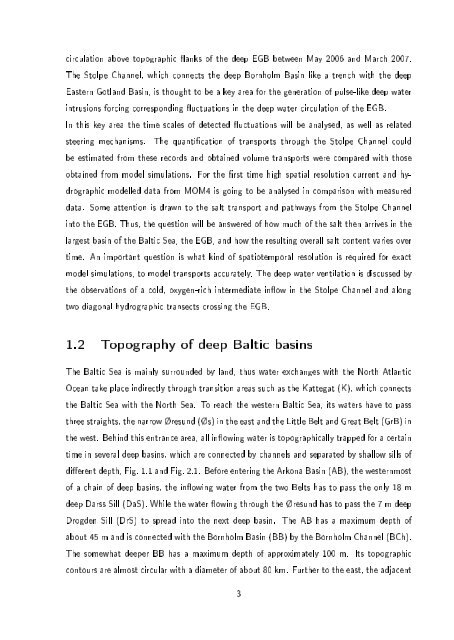Baltic Sea
Baltic Sea
Baltic Sea
You also want an ePaper? Increase the reach of your titles
YUMPU automatically turns print PDFs into web optimized ePapers that Google loves.
circulation above topographic anks of the deep EGB between May 2006 and March 2007.<br />
The Stolpe Channel, which connects the deep Bornholm Basin like a trench with the deep<br />
Eastern Gotland Basin, is thought to be a key area for the generation of pulse-like deep water<br />
intrusions forcing corresponding uctuations in the deep water circulation of the EGB.<br />
In this key area the time scales of detected uctuations will be analysed, as well as related<br />
steering mechanisms. The quantication of transports through the Stolpe Channel could<br />
be estimated from these records and obtained volume transports were compared with those<br />
obtained from model simulations. For the rst time high spatial resolution current and hydrographic<br />
modelled data from MOM4 is going to be analysed in comparison with measured<br />
data. Some attention is drawn to the salt transport and pathways from the Stolpe Channel<br />
into the EGB. Thus, the question will be answered of how much of the salt then arrives in the<br />
largest basin of the <strong>Baltic</strong> <strong>Sea</strong>, the EGB, and how the resulting overall salt content varies over<br />
time. An important question is what kind of spatiotemporal resolution is required for exact<br />
model simulations, to model transports accurately. The deep water ventilation is discussed by<br />
the observations of a cold, oxygen-rich intermediate inow in the Stolpe Channel and along<br />
two diagonal hydrographic transects crossing the EGB.<br />
1.2 Topography of deep <strong>Baltic</strong> basins<br />
The <strong>Baltic</strong> <strong>Sea</strong> is mainly surrounded by land, thus water exchanges with the North Atlantic<br />
Ocean take place indirectly through transition areas such as the Kattegat (K), which connects<br />
the <strong>Baltic</strong> <strong>Sea</strong> with the North <strong>Sea</strong>. To reach the western <strong>Baltic</strong> <strong>Sea</strong>, its waters have to pass<br />
three straights, the narrow Øresund (Øs) in the east and the Little Belt and Great Belt (GrB) in<br />
the west. Behind this entrance area, all inowing water is topographically trapped for a certain<br />
time in several deep basins, which are connected by channels and separated by shallow sills of<br />
dierent depth, Fig. 1.1 and Fig. 2.1. Before entering the Arkona Basin (AB), the westernmost<br />
of a chain of deep basins, the inowing water from the two Belts has to pass the only 18 m<br />
deep Darss Sill (DaS). While the water owing through the Øresund has to pass the 7 m deep<br />
Drogden Sill (DrS) to spread into the next deep basin. The AB has a maximum depth of<br />
about 45 m and is connected with the Bornholm Basin (BB) by the Bornholm Channel (BCh).<br />
The somewhat deeper BB has a maximum depth of approximately 100 m. Its topographic<br />
contours are almost circular with a diameter of about 80 km. Further to the east, the adjacent<br />
3



